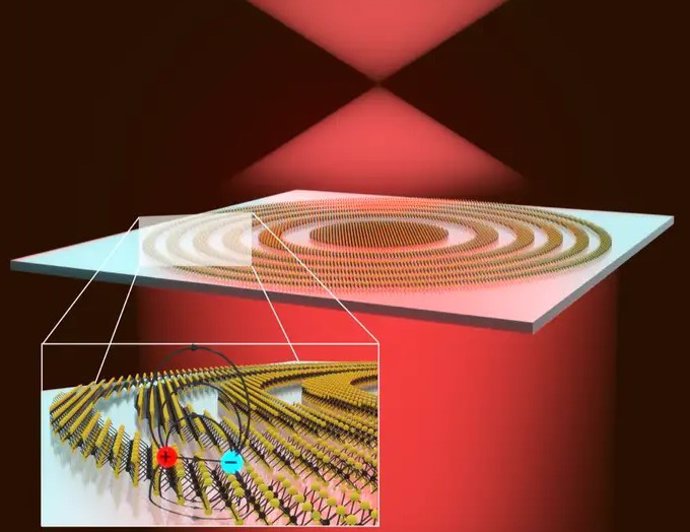Earth’s thinnest lens, made of concentric rings of tungsten disulfide (WS2), uses excitons to focus light efficiently. – LUDOVICA GUARNERI AND THOMAS BAUER.
May 30. () –
Physicists from the University of Amsterdam and Stanford University have created a flat lens just three atoms thick that is based on quantum effects and not in bending and focusing the light.
This type of lenses could be used in future augmented reality glasses, according to the authors of the advance, published in the journal Nano Letters.
Curved glass lenses work because light refracts (bends) when it enters the glass and again when it leaves, which makes things appear larger or closer than they really are. People have used curved lenses for more than two millennia to study the movements of distant planets and stars, reveal tiny microorganisms, and improve vision.
Ludovico Guarneri, Thomas Bauer and Jorik van de Groep of the University of Amsterdam, along with colleagues at Stanford University in California, took a different approach. Using a single layer of a unique material called tungsten disulfide (WS2 for short), they built a flat lens half a millimeter wide, but only 0.0000006 millimeters, or 0.6 nanometers, thick. This makes it the thinnest lens on Earth.
DIFFRACTION INSTEAD OF REFRACTION
Instead of relying on a curved shape, the lens is made of concentric rings of WS2 with spaces between them. This is called a “Fresnel lens” or “zone plate lens” and focuses light using diffraction rather than refraction. The size and distance between the rings (compared to the wavelength of the light hitting them) determines the focal length of the lens. The design used here focuses red light 1mm from the lens
A unique feature of this lens is that its focusing efficiency depends on quantum effects within WS2. These effects allow the material to efficiently absorb and re-emit light at specific wavelengths, giving the lens the built-in ability to perform best at these wavelengths.
This quantum enhancement works in the following way. First, WS2 absorbs light by sending an electron to a higher energy level. Due to the ultrafine structure of the material, the negatively charged electron and the positively charged “hole” it leaves in the atomic lattice remain bound by the electrostatic attraction between them, forming what is known as an “exciton.”
These excitons quickly disappear again as the electron and hole fuse and emit light. This re-emitted light contributes to the efficiency of the lens.
The scientists detected a clear peak in the lenses’ efficiency for the specific wavelengths of light sent by the excitons. While the effect is already observed at room temperature, the lenses are even more efficient when cooled. This is because excitons do their job better at lower temperatures.
Another unique feature of the lens is that while some of the light passing through it forms a bright focal point, most of the light passes through unaffected. While this may seem like a disadvantage, it actually opens new doors for use in future technology.
“The lens can be used in applications where vision through the lens should not be altered, but a small part of the light can be used to collect information. This makes it perfect for wearable glasses such as augmented reality glasses” , Explain it’s a statement Jorik van de Groep, one of the authors of the article.
Researchers are now focusing on designing and testing more complex, multifunctional optical coatings whose function (for example, focusing light) can be electrically adjusted.
“Excitons are very sensitive to the charge density of the material and therefore we can change the refractive index of the material by applying a voltage“says Van de Groep.










![[Img #74129]](https://thelatestnews.world/wp-content/uploads/2024/10/Can-plants-hear-300x200.jpg)

Add Comment